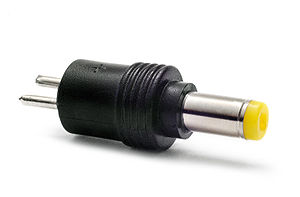
The EIAJ connector type, more formally known as EIAJ RC-5320A, is a type of coaxial power connector or jack for small appliances.

The EIAJ connector type, more formally known as EIAJ RC-5320A, is a type of coaxial power connector or jack for small appliances.
The entire series of connectors has a built-in retention feature. On types 1, 2, and 3 this involves a bevel on the barrel near the tip, while on types 4 and 5 the tip of the insulator ring has a larger diameter than the metal barrel.
The design philosophy is that higher voltages should be supplied via larger plugs to prevent equipment damage. A larger plug will not go into a smaller jack.
| Connector Name | Minimum Voltage | Rated Voltage | Rated Current | Outer Diameter | Inner Diameter | Pin Diameter | Shaft Length | Notes |
|---|---|---|---|---|---|---|---|---|
| EIAJ-01 | 0 V | 3.15 V | 2 A | plug: 2.35 mm jack: 2.75 mm hole | plug: 0.7 mm jack: 0.65 mm pin | none | 9.5~13 mm | Philmore 235 plug/205 PCB jack |
| EIAJ-02 | 3.15 V | 6.3 V | 2 A | plug: 4.0 mm jack: 4.4 mm hole | plug: 1.7 mm jack: 1.65 mm pin | none | 9.5 mm | Philmore 240 plug/TC240 cord/207 PCB jack |
| EIAJ-03 | 6.3 V | 10.5 V | 2 A | plug: 4.75 mm jack: 5.15 mm hole | plug: 1.7 mm jack: 1.65 mm pin | none | 9.5~12 mm | Philmore 275 plug/TC275 cord/220 PCB jack |
| EIAJ-04 | 10.5 V | 13.5 V | 2 A | 5.5 mm | 3.3 mm | 1.0 mm | 9.5~13.5 mm | Philmore 255 plug/Philmore 2559 plug |
| EIAJ-05 | 13.5 V | 18.0 V | 2 A | 6.5 mm | 4.4 mm | 1.4 mm | 9.5~16 mm | Philmore 265 plug/TC265 cord/214 PCB jack |
This standard was originally created in 1992 as EIAJ RC-6705, updated in 1997, and updated again in 2005.
The Electronic Industries Association of Japan (EIAJ) and the Japan Electronic Industries Development Association have merged to form the Japan Electronics and Information Technology Industries Association (JEITA), an electronics and IT industry trade organization.
The use of these connectors on equipment is defined in JEITA ET-2502A. [1] For instance, this document describes the interface between a car cigarette plug or RC-5321 plug and the powered device, the polarity symbol used (JEITA CP-1104A),
This is a unique-looking barrel connector, apparently intended for providing a DC output jack (most DC jacks are used for power input).
Possibly available in multiple voltage ranges, the one for voltage classification 2 (3.15 to 6.3 V) has an outside diameter of 4.75 mm and a protruding pin of 2.5 mm diameter.
Previously known as EIAJ RCX-5321.
According to Hosiden, this is a 12V/24V barrel connector designed for electronic equipment used in cars. The outside diameter is 6.5mm. [ permanent dead link ]
Previously known as EIAJ RCX-5322.
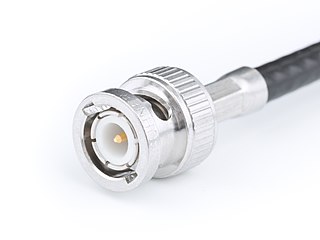
The BNC connector is a miniature quick connect/disconnect radio frequency connector used for coaxial cable. It is designed to maintain the same characteristic impedance of the cable, with 50 ohm and 75 ohm types being made. It is usually applied for video and radio frequency connections up to about 2 GHz and up to 500 volts. The connector has a twist to lock design with two lugs in the female portion of the connector engaging a slot in the shell of the male portion. The type was introduced on military radio equipment in the 1940s and has since become widely applied in radio systems, and is a common type of video connector. Similar radio-frequency connectors differ in dimensions and attachment features, and may allow for higher voltages, higher frequencies, or three-wire connections.

SCART is a French-originated standard and associated 21-pin connector for connecting audio-visual (AV) equipment. The name SCART comes from Syndicat des Constructeurs d'Appareils Radiorécepteurs et Téléviseurs, "Radio and Television Receiver Manufacturers' Association", the French organisation that created the connector in the mid-1970s. The related European standard EN 50049 has then been refined and published in 1978 by CENELEC, calling it péritelevision, but it is commonly called by the abbreviation péritel in French.

Components of an electrical circuit are electrically connected if an electric current can run between them through an electrical conductor. An electrical connector is an electromechanical device used to create an electrical connection between parts of an electrical circuit, or between different electrical circuits, thereby joining them into a larger circuit. Most electrical connectors have a gender – i.e. the male component, called a plug, connects to the female component, or socket. The connection may be removable, require a tool for assembly and removal, or serve as a permanent electrical joint between two points. An adapter can be used to join dissimilar connectors.
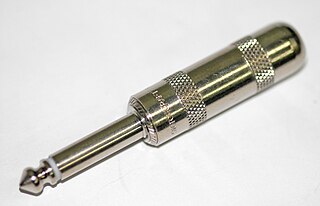
A phone connector, also known as phone jack, audio jack, headphone jack or jack plug, is a family of electrical connectors typically used for analog audio signals. A plug, the "male" connector, is inserted into the jack, the "female" connector.

A DC connector is an electrical connector for supplying direct current (DC) power.
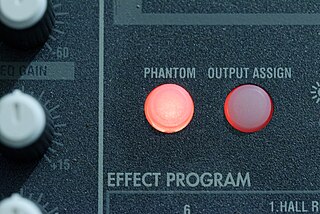
Phantom power, in the context of professional audio equipment, is DC electric power equally applied to both signal wires in balanced microphone cables, forming a phantom circuit, to operate microphones that contain active electronic circuitry. It is best known as a convenient power source for condenser microphones, though many active direct boxes also use it. The technique is also used in other applications where power supply and signal communication take place over the same wires.

The Japan Electronics and Information Technology Industries Association is a Japanese trade organization for the electronics and IT industries. It was formed in 2000 from two earlier organizations, the Electronic Industries Association of Japan and the Japan Electronic Industries Development Association.
AC power plugs and sockets connect electric equipment to the alternating current (AC) mains electricity power supply in buildings and at other sites. Electrical plugs and sockets differ from one another in voltage and current rating, shape, size, and connector type. Different standard systems of plugs and sockets are used around the world.

A banana connector is a single-wire electrical connector used for joining wires to equipment. The term 4 mm connector is also used, especially in Europe, although not all banana connectors will mate with 4 mm parts, and 2 mm banana connectors exist. Various styles of banana plug contacts exist, all based on the concept of spring metal applying outward force into the unsprung cylindrical jack to produce a snug fit with good electrical conductivity. Common types include: a solid pin split lengthwise and splayed slightly, a tip of four leaf springs, a cylinder with a single leaf spring on one side, a bundle of stiff wire, a central pin surrounded by a multiple-slit cylinder with a central bulge, or simple sheet spring metal rolled into a nearly complete cylinder. The plugs are frequently used to terminate patch cords for electronic test equipment such as laboratory power supply units, while sheathed banana plugs are common on multimeter probe leads.

IEC 60309 is a series of international standards from the International Electrotechnical Commission (IEC) for "plugs, socket-outlets and couplers for industrial purposes". They are also referred to as "pin & sleeve" connectors in North America or as "CeeForm" connectors in the entertainment industry. The maximum voltage allowed by the standard is 1000 V DC or AC; the maximum current, 800 A; and the maximum frequency, 500 Hz. The ambient temperature range is −25 °C to 40 °C.

In electrical and mechanical trades and manufacturing, each half of a pair of mating connectors or fasteners is conventionally assigned the designation male or female. The female connector is generally a receptacle that receives and holds the male connector. Sometimes the terms plug and socket or jack are used, particularly in reference to electrical connectors. In some cases, the pins on the connector may have the opposite nominal gender to the mounted connector, such as the RCA connector.
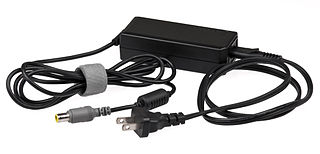
An AC adapter or AC/DC adapter is a type of external power supply, often enclosed in a case similar to an AC plug. Other common names include wall charger, power adapter, power brick, and wall wart. Adapters for battery-powered equipment may be described as chargers or rechargers. AC adapters are used with electrical devices that require power but do not contain internal components to derive the required voltage and power from mains power. The internal circuitry of an external power supply is very similar to the design that would be used for a built-in or internal supply.
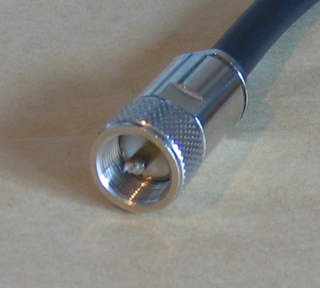
The UHF connector is a name for a threaded RF connector. The connector design was invented in the 1930s for use in the radio industry, and is a shielded form of the "banana plug". It is a widely used standard connector for HF transmission lines on full-sized radio equipment, with BNC connectors predominating for smaller, hand-held equipment.
The Japan Electronic Industry Development Association was an industry research, development, and standards body for electronics in Japan. It was merged with EIAJ to form JEITA on November 1, 2000.

A coaxial power connector is an electrical power connector used for attaching extra-low voltage devices such as consumer electronics to external electricity. Also known as barrel connectors, concentric barrel connectors or tip connectors, these small cylindrical connectors come in an enormous variety of sizes.
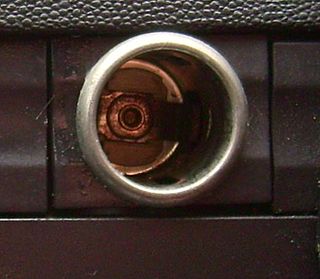
An automobile auxiliary power outlet in an automobile was initially designed to power an electrically heated cigarette lighter, but became a de facto standard DC connector to supply electrical power for portable accessories used in or near an automobile directly from the vehicle's electrical system. Such include mobile phone chargers, cooling fans, portable fridges, electric air pumps, and power inverters.
Founded in 1948, the Electronic Industries Association of Japan (EIAJ) was one of two Japanese electronics trade organizations that were merged into the Japan Electronics and Information Technology Industries Association (JEITA).
Audio connectors and video connectors are electrical or optical connectors for carrying audio or video signals. Audio interfaces or video interfaces define physical parameters and interpretation of signals. For digital audio and digital video, this can be thought of as defining the physical layer, data link layer, and most or all of the application layer. For analog audio and analog video these functions are all represented in a single signal specification like NTSC or the direct speaker-driving signal of analog audio.
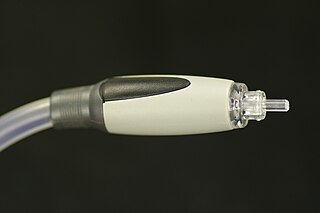
TOSLINK is a standardized optical fiber connector system. Also known generically as optical audio, its most common use is in consumer audio equipment, where it carries a digital audio stream from components such as CD and DVD players, Digital Audio Tape recorders, computers, and modern video game consoles, to an AV receiver that can decode two channels of uncompressed pulse-code modulated (PCM) audio or compressed 5.1/7.1 surround sound such as Dolby Digital or DTS Surround System. Unlike HDMI, TOSLINK does not have the bandwidth to carry the uncompressed versions of Dolby TrueHD, DTS-HD Master Audio, or more than two channels of PCM audio.

The CCJ connector, also known as a J-type connector or an EIAJ connector, is the specification for a 10-pin DIN-style connector established by member companies of the Electronic Industries Association of Japan (EIAJ) in the late 1960s to interconnect various pieces of video camera equipment. Within Japanese-built video camera equipment built from the late 1960s to the mid-1980s, the CCJ connector was especially widely used to connect video cameras to video tape recorders (VTRs), especially battery-powered portable VTRs—so-called portapacks—which were common before the dawn of camcorders, which married both the camera and the VTR.